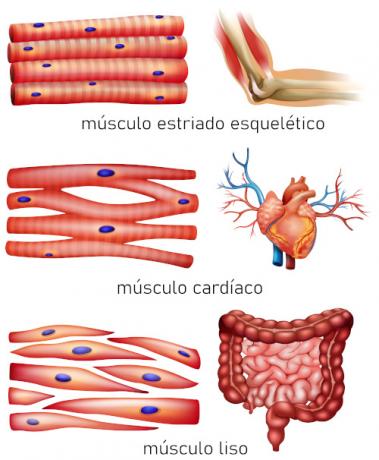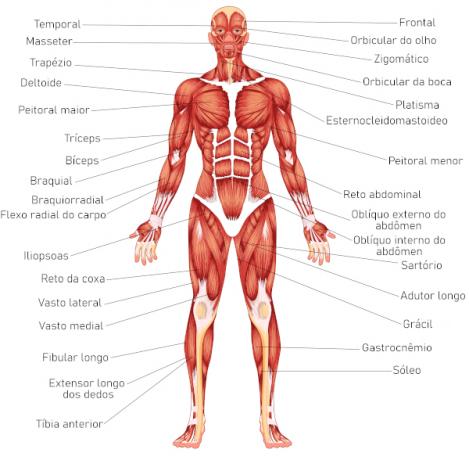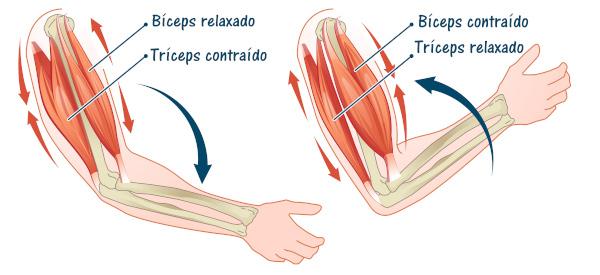You human body musclesform the muscular system. Skeletal striated muscles, together with the skeletal system and the nervous system, are responsible for the perceptible movements of our daily lives, such as walking, writing, playing ball or catching objects.
When we hear someone mention that they want to “build muscle” in the gym, they are referring to this type of muscle tissue. After death, these muscles stiffen, making their movement difficult, a phenomenon known as cadaveric rigidity.
In addition to skeletal striated muscles, the muscular system is also composed of two other types: the cardiac striated muscle and smooth (or non-striated) muscle, which play different roles in the body.
Read too: How many bones does the human skeleton have?
Summary about the muscles of the human body
The muscular system is made up of three types of muscle: skeletal, cardiac, and smooth muscle.
Skeletal striated muscle acts in the external movements of the body in conjunction with the nervous system, skeletal system and joints.
Skeletal striated muscles are divided into groups: muscles of the face and head, muscles of the chest and abdomen, and muscles of the upper and lower limbs.
Muscles work in pairs: while one contracts, the other relaxes.
Cadaveric stiffness is the process of muscle stiffening after death.
What are the types of muscle in the human body?
It is important to understand the different types in order to have a comprehensive view of the muscular system. Therefore, we will make a brief explanation about all the types of muscle tissue. The muscles of the human body are classified into three types. according to their morphological and functional characteristics:
Skeletal striated muscle: it is formed by bundles of very long and multinucleated cylindrical cells (several nuclei), which have transverse striations. These cells have rapid and voluntary contraction, that is, their activity can be triggered according to our will. Skeletal striated muscle is attached to bones and, together with the joints and the nervous system, is responsible for the external movement of the body, such as locomotion, facial expressions and the movement of picking up an object.
Cardiac striated muscle: it is made up of elongated, branched and striated cells that are united by means of a structure found only in this type of muscle: the intercalated discs. The contraction of these cells is rhythmic and involuntary, that is, we cannot control it. that muscle is found only in the heart and is responsible for the beats of that organ.
Smooth or non-striated muscle: it is formed by clusters of fusiform cells without transverse striations. The contraction of these cells is slow and involuntary. the smooth muscle plays an important role in the movements of internal organs, like those related to the digestive system or vascular.

What are the main muscles in the human body?
There are approximately 600 skeletal striated muscles in the human body. Between them, the smallest is the stapedius muscle, located in the middle ear, about 1.5 centimeters long. On the other hand, the biggest muscle is the gluteus maximus, found in the buttocks region and responsible for the extension and rotation of the thigh.
Skeletal striated muscles are grouped in different regions of the body:

-
Muscles of the head and neck: are composed of more than 40 muscles. They play essential roles in human communication, being involved in facial expressions and speech production. In addition, they play an important role in chewing and stabilizing the head. Some examples are:
Front: chewing or biting action.
Masseter: Elevation and protrusion of the jaws, allowing for movement.
Zygomatic: traction of the upper lip, allowing the expression of a smile.
Sternocleidomastoid: stabilization of the head, allowing it to rotate or tilt forward and backward.
-
Muscles of the chest and abdomen: they play important roles in stabilizing the trunk, posture, breathing, and supporting and protecting vital organs in the chest and abdomen. Some examples are:
trapeze: shoulder lift.
Pectoralis major: forward movement of the arms.
Intercostals: expansion and contraction of the rib cage along with the diaphragm during breathing.
rectus abdominis: flexion of the thorax over the abdomen.
-
Upper limb muscles: are involved in the movements of the arms, shoulders, elbows, hands and fingers. Some examples are:
Deltoid: action of raising the arm laterally.
Hand flexors and extensors: action of opening and closing hands.
Biceps and Triceps: forearm flexion and extension.
Rotator cuff: shoulder joint stabilization and arm rotation movements.
-
Lower limb muscles: Located in the legs and feet, these muscles help move the knees, hips, ankles, and feet. They are fundamental for activities such as walking, running, crouching, climbing stairs and playing sports. They provide support, stability and strength to support the body's weight, perform coordinated movements and maintain balance during daily activities.
Glutes: keeping thighs apart and upright posture.
Hamstring muscles: knee flexion.
Sartorius: action of crossing the legs.
Gastrocnemius and soleus: plantar flexion, allowing for the tiptoe position.
See too: What are the bones of the foot?
How do muscles act in movement?
The movement of the human body is the result of the interaction between the skeleton, skeletal striated muscles, joints and the nervous system. the nervous system sends nerve impulses through neurons to muscles, triggering your contraction or relaxation and consequently moving the bones to which they are connected.
Many of these muscles work in pairs.; while one contracts, the other relaxes. Joints (where two bones meet) play an important role in allowing certain movements, such as wrist flexion.

Cadaverous stiffness of the muscles
After dead, the muscles of the cadaver become rigid through a phenomenon known as cadaveric rigidity or rigor mortis. Joints become stiff to the point where they cannot be flexed. Cadaveric stiffness can last up to three days, depending on the ambient temperature. From this, the muscles begin to break down. This characteristic is used by medical examiners as a source of data to assess the time of death of a cadaver.
Know more: What happens to muscles, bones and joints as we age
Solved exercises on the muscles of the human cup
question 1 (UEA) In the wall of the stomach, in the biceps and in the walls of the arteries, we find muscle tissues, respectively:
a) smooth, skeletal striated and smooth types.
b) of the skeletal, smooth and smooth striated types.
c) skeletal striated, skeletal striated and smooth types.
d) of the skeletal striated, skeletal striated and skeletal striated types.
e) smooth, flat and smooth types.
Response: letter a. Smooth muscle tissue is present in the walls of the stomach and arteries. The biceps is composed of striated skeletal muscle tissue.
question 2 (IFSul) The muscle tissue allows the movements of the skeleton and internal organs such as the heart, stomach, uterus, arteries and others, by converting chemical energy into mechanical energy. Among the types of muscle tissue, there is the skeletal muscle tissue, which has the following characteristics:
a) have a single nucleus, have slow involuntary contraction, be found in blood vessels and organs of the digestive system.
b) have many nuclei, have voluntary contraction, be found attached to bones by means of tendons.
c) almost always have a single nucleus, have involuntary contraction, present intercalated discs, and be found only in the heart.
d) have many nuclei, have voluntary contraction, present intercalated discs, be found in organs of the digestive system.
Response: letter B. Skeletal striated cells are multinucleated and exhibit voluntary contraction. Skeletal striated muscle is attached to bone by tendon.
question 3 (Uncisal) A person who works out at the gym gets “bloated” because physical activity stimulates cells already existing ones to increase their volume and, consequently, we see the growth of the biceps, gastrocnemius and others.
(S. Lopes, Bio, single volume. Adapted)
The quoted passage refers to the fabric:
a) smooth muscle.
b) striated skeletal muscle.
c) conjunctive proper.
d) cartilaginous connective tissue.
e) dense connective tissue.
Response: letter B. The type of tissue that develops in the practice of physical activities is skeletal muscle.
Sources
JUNQUEIRA, L.C.U.; CARNEIRO, J. Basic Histology. 12 ed. Rio de Janeiro: Guanabara Koogan, 2013. 558 p.
Mukund, K.; Subramanian, S. Skeletal muscle: A review of molecular structure and function, in health and disease. Wiley Interdiscip Rev Syst Biol Med. 2020. 12(1): e1462.
SHEDGE, R.; KRISHAN, K.; WARRIER, V. et al. Postmortem Changes. In: StatPearls. Treasure Island (FL): StatPearls Publishing. Available in: https://www.ncbi.nlm.nih.gov/books/NBK539741/.
TANG, A.; BORDONI, b. Anatomy, Thorax, Muscles.In: StatPearls. Treasure Island (FL): StatPearls Publishing. Available in: https://www.ncbi.nlm.nih.gov/books/NBK538321/.
WESTBROOK, K.E.; NESSEL, T.A.; HOHMAN, M.H. et al. Anatomy, Head and Neck: Facial Muscles.In: StatPearls. Treasure Island (FL): StatPearls Publishing. Available in: https://www.ncbi.nlm.nih.gov/books/NBK493209/.
By Heloisa Fernandes Flores
Biology teacher
Source: Brazil School - https://brasilescola.uol.com.br/biologia/musculos-do-corpo-humano.htm
